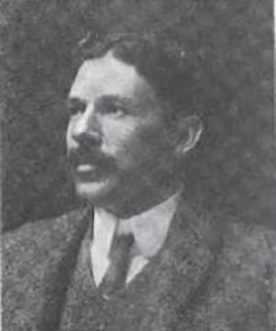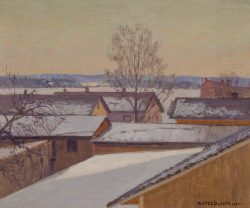Alfred Jansson, from a photograph reproduced in Ernst W. Olson, ed., History of the Swedes in Illinois. Part 1 (Chicago: The Engberg-HoImberg Publishing Company, 1908).

Alfred Jansson 1863–1931
Born in the province of Vermland, Sweden, Alfred Jansson studied art in Stockholm, Oslo, and Paris. He immigrated to America and settled in Chicago in 1889, but he did not become a U.S. citizen until 1922. Jansson continued his art studies in his adopted city and painted murals in the Swedish Building at the World’s Columbian Exposition of 1893. For more than two decades beginning in 1898, he was a prolific exhibitor in the Art Institute of Chicago’s annual exhibitions, showing landscape paintings exclusively. Jansson worked in oils and occasionally also in watercolors and pastel. His subjects, rarely specified in his titles, were drawn from the Chicago region as well as from his native country, which he revisited at least once, in the early 1920s. Jansson was particularly noted for his winter scenes, one of which earned him the Art Institute’s Clyde M. Carr Prize in 1914.
Jansson belonged to such organizations as the Palette and Chisel Club, the Chicago Society of Artists, and the Artists’ Guild, but he was particularly active in the local community of Swedish-American artists. He was a juror for the first and only exhibition of the short-lived Swedish-American Art Association in 1905, and between 1911 and 1924 he participated in the annual “Exhibition of Works by Swedish-American Artists” at the Swedish Club of Chicago, of which he and Arvid Nyholm were founding members. Jansson was one of seven artists who painted murals in the Swedish Club’s banquet hall, a project completed in 1922. He was represented in “American Painters of Swedish Descent,” an exhibition that traveled to New York and three cities in Sweden before appearing at the Art Institute in 1920.
Two of Jansson’s landscapes were included in the art exhibition at the 1915 Panama-Pacific International Exposition in San Francisco. At Thurber’s Art Galleries in Chicago he was the subject of a solo show in 1916 and a joint exhibition (with Charles Warren Eaton) in 1918, both of which were covered in feature articles in the Chicago-based Fine Arts Journal. “His work is imbued with poetry,” noted one reviewer, “and carries that rich quality which is so much loved by the devotees of the modern landscape school.”i Another solo exhibition followed in 1922 at J. W. Young Galleries and in 1932, following the artist’s death, the Midland Club hosted a memorial display of Jansson’s landscape paintings that prompted Chicago Tribune critic Eleanor Jewett to call him “one of the finest portrayers of snow we have ever had.”ii
Wendy Greenhouse, PhD
i Dalzelle Harry Hatfield, “The Jansson-Eaton Exhibition,” Fine Arts Journal 36 (May 1918): 34.
ii Eleanor Jewett, “Current Exhibits Intrigue and Interest,” Chicago Tribune, Mar. 13, 1932.

